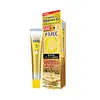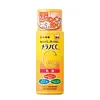What's inside
What's inside
 Key Ingredients
Key Ingredients

 Benefits
Benefits

 Concerns
Concerns

 Ingredients Side-by-side
Ingredients Side-by-side

Butylene Glycol
HumectantPropanediol
SolventIsopentyldiol
HumectantPropylene Glycol
HumectantPEG-8
HumectantWater
Skin ConditioningAscorbic Acid
AntioxidantAlcohol
AntimicrobialPPG-6-Decyltetradeceth-30
EmulsifyingParfum
MaskingTocopherol
AntioxidantPyridoxine Hcl
Skin ConditioningAllantoin
Skin ConditioningO-Cymen-5-Ol
AntimicrobialAscorbyl Tetraisopalmitate
AntioxidantSodium Metabisulfite
AntioxidantAlpinia Katsumadai Seed Extract
Skin ConditioningDisodium EDTA
3-O-Ethyl Ascorbic Acid
Skin ConditioningAscorbyl Glucoside
AntioxidantSerine
MaskingCitrus Limon Fruit Extract
MaskingCitrus Grandis Fruit Extract
AstringentButylene Glycol, Propanediol, Isopentyldiol, Propylene Glycol, PEG-8, Water, Ascorbic Acid, Alcohol, PPG-6-Decyltetradeceth-30, Parfum, Tocopherol, Pyridoxine Hcl, Allantoin, O-Cymen-5-Ol, Ascorbyl Tetraisopalmitate, Sodium Metabisulfite, Alpinia Katsumadai Seed Extract, Disodium EDTA, 3-O-Ethyl Ascorbic Acid, Ascorbyl Glucoside, Serine, Citrus Limon Fruit Extract, Citrus Grandis Fruit Extract
Ascorbyl Glucoside
AntioxidantDipotassium Glycyrrhizate
HumectantAscorbic Acid
AntioxidantCitrus Limon Fruit Extract
MaskingHydrolyzed Grape Fruit Extract
HumectantAlpinia Zerumbet Seed Extract
AntimicrobialGlycerin
HumectantButylene Glycol
Humectant1,5-Pentanediol
SolventIsopentyldiol
HumectantGlyceryl Heptanoate
EmollientSorbitan Stearate
EmulsifyingCetearyl Alcohol
EmollientPolyethylene
AbrasiveParaffinum Liquidum
EmollientDimethicone
EmollientPotassium Hydroxide
BufferingPhenoxyethanol
PreservativeBehenyl Alcohol
EmollientSodium Citrate
BufferingAcrylates/C12-22 Alkyl Methacrylate Copolymer
Xanthan Gum
EmulsifyingEDTA
Hydroxyethylcellulose
Emulsion StabilisingCitric Acid
BufferingWater
Skin ConditioningParfum
MaskingAscorbyl Glucoside, Dipotassium Glycyrrhizate, Ascorbic Acid, Citrus Limon Fruit Extract, Hydrolyzed Grape Fruit Extract, Alpinia Zerumbet Seed Extract, Glycerin, Butylene Glycol, 1,5-Pentanediol, Isopentyldiol, Glyceryl Heptanoate, Sorbitan Stearate, Cetearyl Alcohol, Polyethylene, Paraffinum Liquidum, Dimethicone, Potassium Hydroxide, Phenoxyethanol, Behenyl Alcohol, Sodium Citrate, Acrylates/C12-22 Alkyl Methacrylate Copolymer, Xanthan Gum, EDTA, Hydroxyethylcellulose, Citric Acid, Water, Parfum
 Reviews
Reviews

Ingredients Explained
These ingredients are found in both products.
Ingredients higher up in an ingredient list are typically present in a larger amount.
Ascorbic Acid is is pure Vitamin C. This form makes up the largest amount of vitamin C found naturally in our skin.
Not only is vitamin C great for your overall health and immune system, it also has plenty of benefits on your skin.
Vitamin C is best used for brightening skin. It improves dark spots, acne scars, and hyperpigmentation. This is because it blocks the process of skin darkening when exposed to UV.
Remember: Vitamin C should not replace sunscreen!
Your skin uses vitamin C to build collagen. Collagen is one key component in having a strong skin barrier and plump skin. Vitamin C also plays a role in regulating collagen, thus making it effective in improving wrinkles and fine lines.
Ascorbic acid shows potent antioxidant activity. As an antioxidant, it helps fight free-radicals. Free-radicals are molecules that may damage your skin cells. These antioxidants also protect skin against UV damage.
The best formulations include Vitamin E and/or ferulic acid. These two ingredients help stabilize and provide a boost in the benefits of ascorbic acid. This is because ascorbic acid becomes unstable when exposed to UV and air. In fact, you can tell your ascorbic acid has oxidized when it turns an orange-yellow color.
Ascorbic acid is generally compatible with other ingredients. However, using ascorbic acid with other active ingredients might cause irritation. Two ingredients: copper ions and benzoyl peroxide, will inactivate ascorbic acid completely.
Read more about other types of Vitamin C:
Foods rich with vitamin C include oranges, strawberries, broccoli, bell peppers, and more. When consuming Vitamin C, your skin receives a portion of the nutrients.
Learn more about Ascorbic AcidAscorbyl Glucoside is a stable form of Vitamin C. It is created by combining glucose from starch.
When applied to skin, Ascorbyl Glucoside turns into Ascorbic Acid.
Ascorbyl Glucoside is an antioxidant. Antioxidants help fight free-radicals, or molecules that may damage skin cells.
It can help to reduce redness, improve skin texture, reduce the effects of aging, reduce the visibility of dark spots, and brighten skin.
Read more about other types of Vitamin C:
Learn more about Ascorbyl GlucosideButylene Glycol (or BG) is used within cosmetic products for a few different reasons:
Overall, Butylene Glycol is a safe and well-rounded ingredient that works well with other ingredients.
Though this ingredient works well with most skin types, some people with sensitive skin may experience a reaction such as allergic rashes, closed comedones, or itchiness.
Learn more about Butylene GlycolCitrus Limon Fruit Extract comes from lemons. While lemon extract is exfoliating and antimicrobial, it can also cause skin sensitivity.
Lemons contains antioxidants, which may help with anti-aging. They are also rich in citric acid, an AHA.
And of course, lemons are rich in Vitamin C. Vitamin C helps with skin-brightening and increasing collagen production.
The acidity of lemons may work as an astringent for acne.
However, lemons can also cause skin sensitivity due to its limonene content. It can also increase photosensitivity, or sensitivity to the sun.
This ingredient is also used to add a lemon scent to products.
Learn more about Citrus Limon Fruit ExtractIsopentyldiol is a synthetic solvent, humectant, and emollient.
Humectants have the ability to attract and hold water while emollients create a thin film to prevent water from evaporating. This combination keeps your skin and hair soft and hydrated. Plus, isopentyldiol does not leave a sticky feeling behind.
As a surfactant, isopentyldiol is a hydrotrope. Hydrotropes help surfactants (cleansing agents) dissolve into water.
According to the manufacturer, using this ingredient with sorbitol boosts skin hydration and helps close cuticles of damaged hair.
This ingredient is water-soluble.
Learn more about IsopentyldiolParfum is a catch-all term for an ingredient or more that is used to give a scent to products.
Also called "fragrance", this ingredient can be a blend of hundreds of chemicals or plant oils. This means every product with "fragrance" or "parfum" in the ingredients list is a different mixture.
For instance, Habanolide is a proprietary trade name for a specific aroma chemical. When used as a fragrance ingredient in cosmetics, most aroma chemicals fall under the broad labeling category of “FRAGRANCE” or “PARFUM” according to EU and US regulations.
The term 'parfum' or 'fragrance' is not regulated in many countries. In many cases, it is up to the brand to define this term.
For instance, many brands choose to label themselves as "fragrance-free" because they are not using synthetic fragrances. However, their products may still contain ingredients such as essential oils that are considered a fragrance by INCI standards.
One example is Calendula flower extract. Calendula is an essential oil that still imparts a scent or 'fragrance'.
Depending on the blend, the ingredients in the mixture can cause allergies and sensitivities on the skin. Some ingredients that are known EU allergens include linalool and citronellol.
Parfum can also be used to mask or cover an unpleasant scent.
The bottom line is: not all fragrances/parfum/ingredients are created equally. If you are worried about fragrances, we recommend taking a closer look at an ingredient. And of course, we always recommend speaking with a professional.
Learn more about ParfumWater. It's the most common cosmetic ingredient of all. You'll usually see it at the top of ingredient lists, meaning that it makes up the largest part of the product.
So why is it so popular? Water most often acts as a solvent - this means that it helps dissolve other ingredients into the formulation.
You'll also recognize water as that liquid we all need to stay alive. If you see this, drink a glass of water. Stay hydrated!
Learn more about Water